
Last Sunday, over lunch, I was telling Goon about how I wanted to enter WTSIM no 5 (which Cooksister Jeanne is hosting) but was totally stuck on ideas. The theme this time was stuffed vegetables and fruits. Goon had a suggestion.
GOON: I know what you can stuff. I’ve seen green wrinkly things. The label said you can stuff them.
ME: Any idea what they are?
GOON: Green wrinkly things.
ME: But what are they called?
GOON: I don’t know. But they’re green and wrinkly.
I was clearly going to get no more information about the mystery vegetable from him and I mentally dismissed the green wrinkly things as some figment of Goon’s imagination. But, that evening, six of them appeared in the kitchen.

I recognised them immediately, although I think I’d describe them as more knobbly than wrinkly. Goon had picked up kerala, which had appeared in my mother’s kitchen from time to time when I was little. It’s a vegetable which, like courgettes and sprouts, drives fear into the hearts of small children.
Here the vegetable is known as bitter gourd. It’s called that for a good reason. In order to remind myself what the kerala tasted like, I cut a tiny sliver from the middle of the largest one and tasted.
For a second I thought it wasn’t so bad but, literally a few seconds later, there seemed to be a small chemical war going on in my mouth. My face contorted and I made a noise that was something like “GAAAAAAAH!” The next ten minutes were spent trying desperately to drown out the flavour with cherry brandy. It didn’t go easily. *
I was seriously dubious about trying anything with the green knobbly gourd but, since Goon had gone to all the effort of getting it, I thought I’d better make an attempt at cooking it. Some people actively like it, so there must be something I could do to de-bitter my kerala.
I called up my parents to see if they could help me make this strange vegetable edible. Apparently they’d only ever used them in salads and curries, which didn’t really help me with my plans for stuffing, but cooking with sugar and tamarind seemed to be a common theme. The internet also provided me with some help. The bitterness of the kerala could be reduced by scraping off some skin, deseeding it, rubbing it with salt and soaking in cold water. I decided to try and balance the bitter flavour with a very strong sweet and sour stuffing made from tomato, onion, and lots of sugar and tamarind. After all, it works for chicory. The dish would be an accompaniment to a Sri-Lankan style goat curry.
I didn’t really know what to expect from my kerala as I began to prepare them, but scraping off the skin was easy enough. It did however leave a big green mess in the kitchen.
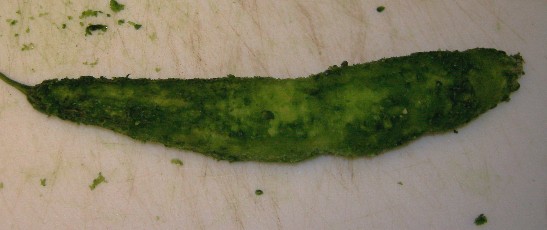
Once the skin was off, I cut the kerala in half and looked inside. Like many gourds, it had a clear divide between the flesh and seed area.
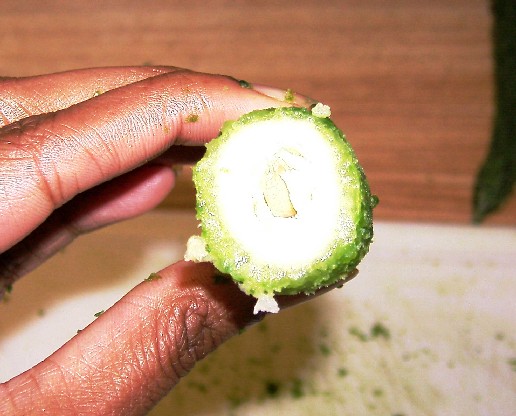
A small knife was ideal to scrape out the seeds. Now there was a cylindrical hole in the gourd which was a perfect shape and size for stuffing.
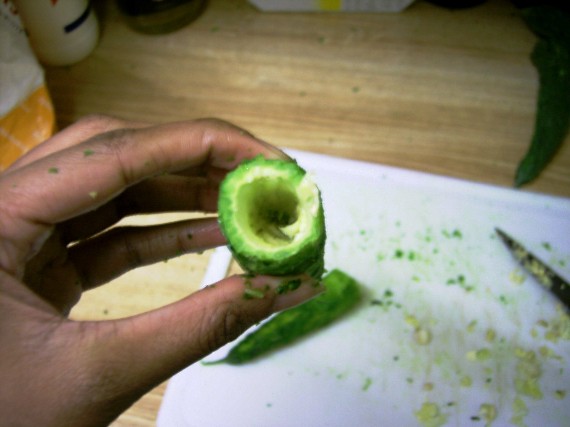
So the gourds were salted and soaked for an hour whilst I finished preparing the rest of our dinner: the slow cooked goat curry and spiced rice. I also made a lot of dahl, just in case the gourd was inedible.
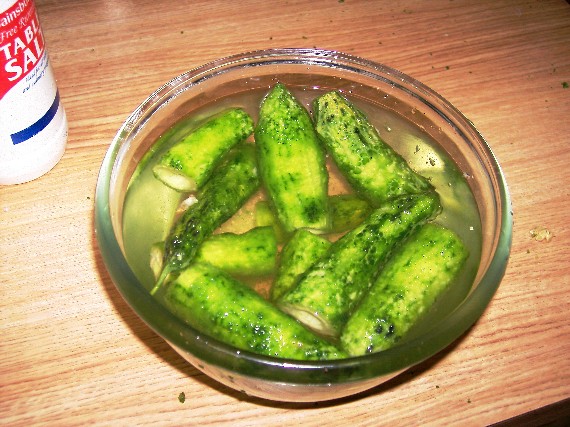
The tomato chutney stuffing for the gourd was simple to make. I sweated some onion, added a couple of fresh chopped tomatoes, tomato puree and coriander, then added lots of sugar, tamarind and just a drop or two of vinegar to make it really sweet and tangy. Once the gourds were stuffed I cooked them in the excess tomato concoction.
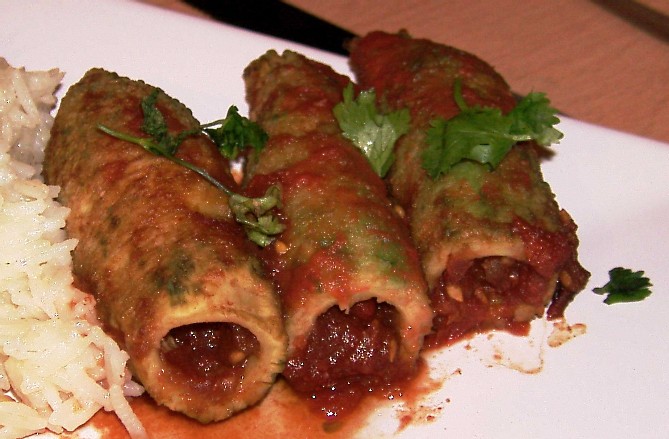
Now, maybe Goon accidentally found the bitterest bitter gourds in the shop, but even after lots of soaking, these things were still not very nice. Goon ate one piece and said “Why the heck would anyone voluntarily eat these things?” I have to admit, I was thinking the same thing. The sweet and sour flavour certainly helped but, after a few bites, the bitterness was overwhelming. I can’t believe that some people actually eat it without salting it first!
So, if you happen to be a bitter gourd fan, good for you. I don’t get it but I think the sweet-sour thing turned it from totally inedible to the point where I could manage a piece or two. Fortunately there was plenty of curry so we didn’t go hungry.
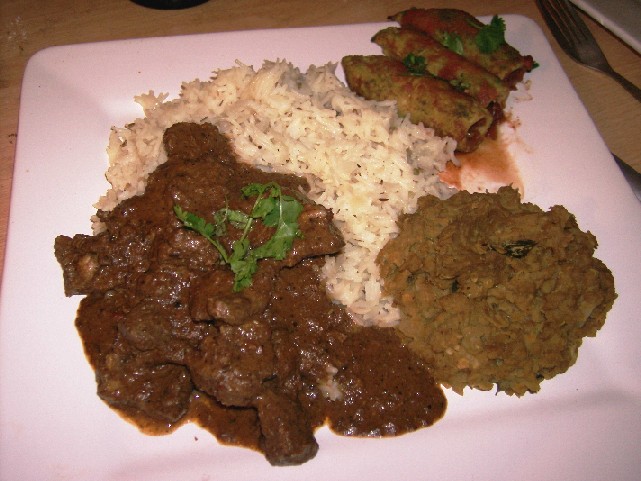
This is my entry to this month’s Waiter, Waiter event. The roundup will be on Jeanne’s blog very soon, so go and check out the other entries. I’m sure that, unlike me, most people even made something they could eat!
* Which meant I had to drink a lot of cherry brandy. Shame. 
Last Sunday, over lunch, I was telling Goon about how I wanted to enter WTSIM no 5 (which Cooksister Jeanne is hosting) but was totally stuck on ideas. The theme this time was stuffed vegetables and fruits. Goon had a suggestion.
GOON: I know what you can stuff. I’ve seen green wrinkly things. The label said you can stuff them.
ME: Any idea what they are?
GOON: Green wrinkly things.
ME: But what are they called?
GOON: I don’t know. But they’re green and wrinkly.
I was clearly going to get no more information about the mystery vegetable from him and I mentally dismissed the green wrinkly things as some figment of Goon’s imagination. But, that evening, six of them appeared in the kitchen.
I recognised them immediately, although I think I’d describe them as more knobbly than wrinkly. Goon had picked up kerala, which had appeared in my mother’s kitchen from time to time when I was little. It’s a vegetable which, like courgettes and sprouts, drives fear into the hearts of small children.
Here the vegetable is known as bitter gourd. It’s called that for a good reason. In order to remind myself what the kerala tasted like, I cut a tiny sliver from the middle of the largest one and tasted.
For a second I thought it wasn’t so bad but, literally a few seconds later, there seemed to be a small chemical war going on in my mouth. My face contorted and I made a noise that was something like “GAAAAAAAH!” The next ten minutes were spent trying desperately to drown out the flavour with cherry brandy. It didn’t go easily. *
I was seriously dubious about trying anything with the green knobbly gourd but, since Goon had gone to all the effort of getting it, I thought I’d better make an attempt at cooking it. Some people actively like it, so there must be something I could do to de-bitter my kerala.
I called up my parents to see if they could help me make this strange vegetable edible. Apparently they’d only ever used them in salads and curries, which didn’t really help me with my plans for stuffing, but cooking with sugar and tamarind seemed to be a common theme. The internet also provided me with some help. The bitterness of the kerala could be reduced by scraping off some skin, deseeding it, rubbing it with salt and soaking in cold water. I decided to try and balance the bitter flavour with a very strong sweet and sour stuffing made from tomato, onion, and lots of sugar and tamarind. After all, it works for chicory. The dish would be an accompaniment to a Sri-Lankan style goat curry.
I didn’t really know what to expect from my kerala as I began to prepare them, but scraping off the skin was easy enough. It did however leave a big green mess in the kitchen.
Once the skin was off, I cut the kerala in half and looked inside. Like many gourds, it had a clear divide between the flesh and seed area.
A small knife was ideal to scrape out the seeds. Now there was a cylindrical hole in the gourd which was a perfect shape and size for stuffing.
So the gourds were salted and soaked for an hour whilst I finished preparing the rest of our dinner: the slow cooked goat curry and spiced rice. I also made a lot of dahl, just in case the gourd was inedible.
The tomato chutney stuffing for the gourd was simple to make. I sweated some onion, added a couple of fresh chopped tomatoes, tomato puree and coriander, then added lots of sugar, tamarind and just a drop or two of vinegar to make it really sweet and tangy. Once the gourds were stuffed I cooked them in the excess tomato concoction.

Now, maybe Goon accidentally found the bitterest bitter gourds in the shop, but even after lots of soaking, these things were still not very nice. Goon ate one piece and said “Why the heck would anyone voluntarily eat these things?” I have to admit, I was thinking the same thing. The sweet and sour flavour certainly helped but, after a few bites, the bitterness was overwhelming. I can’t believe that some people actually eat it without salting it first!
So, if you happen to be a bitter gourd fan, good for you. I don’t get it but I think the sweet-sour thing turned it from totally inedible to the point where I could manage a piece or two. Fortunately there was plenty of curry so we didn’t go hungry.
This is my entry to this month’s Waiter, Waiter event. The roundup will be on Jeanne’s blog very soon, so go and check out the other entries. I’m sure that, unlike me, most people even made something they could eat!
* Which meant I had to drink a lot of cherry brandy. Shame. ![]()



Oh Ros, how you had to suffer for your art. I mean, being forced to drink cherry brandy… Poor lamb
Seriously, kudos to you for eating the inedible in the interests of research! I’ve also seen these little suckers in our local Sainsbury’s but never actually bought them… and won’t be any time soon!
Thanks for a very amusing WTSIM entry & hope to see you again next month
Comment by Jeanne — May 31, 2007 @ 9:02 pm
I think mamta has a lot of recipes for it on her website - www.mamtaskitchen.com
My grandmother used to stuff bitter melon with pork mince and prawns. I’d eat the stuffing and leave the rest in the hope that i’d get away with it. I never did!
Comment by Schmoofaloof — June 1, 2007 @ 12:45 pm
At least you tried! And now you’ve deterred us all from trying it - you pioneered the kerala! The rest of the food looks really good!
Comment by Freya — June 1, 2007 @ 4:37 pm
That is quite possibly the most disgusting thing to be foisted on humankind; I don’t know anyone who’d consume it sans protest.
Kudos to you for trying though!
x
Comment by S — June 1, 2007 @ 4:55 pm
Hi Ros, a very amusing post as usual. Now I’ll know never to substitute these for okra (not that I’ve ever come acorss them before). Are they named Kerala after the Southern Indian state they originate from by any chance?
Comment by Trig — June 1, 2007 @ 5:11 pm
Jeanne- It’s a tragedy- I have no more cherry brandy left thanks to that damned gourd! Thanks for hosting this event- it is great fun and apologies again for the late entry.
Thanks for hosting this event- it is great fun and apologies again for the late entry.
Schmoof - I do have two more of these things in the fridge but I’m not sure I can bring myself to have them again so soon. If I ever muster up the courage I’ll try one of Mamta’s recipes. I can’t believe I forgot to check her website when researching this vegetable!
Freya - Like you, I’ll try almost anything once but these won’t be cooked by me for a long time yet. Yuck!
S- Glad I’m not the only one who hates these things. Supposedly they’re an acquired taste but I don’t know why anyone would put in the effort to acquire it.
Trig- I don’t think it’s named after the state, the pronunciation of the name is different. the vegetable has all short vowels ‘Ke- ru- la,’ not ‘Ke-rah-la’ like the state. I’ve seen different spellings for this vegetable too- Karala and Karela mostly.
Comment by ros — June 1, 2007 @ 6:20 pm
Hi - just wanted to say I really enjoy reading your blog. I’m half-Sri Lankan and spent a few years there and so miss the traditional vegetables like gotukola, bread fruit and even bitter gourd as you have featured.
This vegetable is called “kara-wila” and is best eaten as a “sambol”. All you do is slice them into thin rings and season with salt, chilli and turmeric. Deep fry in batches and drain well. Mix with sliced red onion, green chillies and tomatoes with a good squeeze of lime. Its really delicious with Sri Lankan-style rice and curry. Try it this way and if this method fails to impress, then it’s probably safe to give up! All the best and keep up the great blog.
All the best and keep up the great blog.
Comment by Deanna — March 9, 2008 @ 7:29 pm
Hi Ros,
I have many friends who disliked the
taste of bitter gourds too, so I am the odd one out:)
The part I find it amusing was the scraping off the skin,
which I’ve never thought about.
Enjoyed reading your blog and keep it coming ^-^
Comment by Viv;=) — April 1, 2008 @ 7:43 am
Very interested in yr topic for very different reason.
I have type 2 diabetes and have been recommended to boil bitter gourd in water and drink the water which is supposed to reduce blood/sugar levels. This has come from my manager in Singapore, who is herself Chinese.
The question is where to get this bitter vegetable in the UK. I live in East Anglia and anything like this appears to be seasonal, I have phoned many wholesalers.
Perhaps you have a ready supply in your area and would be kind enough to divulge that information.
Thanking you in advance
Robin Curtis (Mr.)
Comment by Robin Curtis — May 16, 2008 @ 4:37 pm
Just to say that this piece had us screaming out loud with laughter-
especially as we’d just espied the said knobbly fruit at a market stall, been advised on its bitterness and how to cook it and still decided to try it out.
It was the BITTEREST, VILEST, MOST UNSWALLOWABLE thing I have ever had in my mouth!!!!
Fab writing and pictures ensured noone will EVER eat that vegetable/fruit/alien nastie again xxxx
Comment by alex peters-out — September 18, 2010 @ 7:58 pm
Hi, I know this is a long time afterwards but I have to say I love Kerala. I usually make a stew with just the skin. I cut the kerala in half, remove the seeds and chops medium fine. I then leave this soaked in sugar and salt for at least an hour or overnight to draw out the bitterness. Squeeze the kerala to remove the kerala and cook in an abundance of coconut milk until soft. Eat with rice.
After your ordeal I doubt whether you’d be willing to try this but just wanted to share
Comment by Ronita — October 24, 2010 @ 11:50 am
I am a big fan of kerala. We tend to stuff it with minced lamb. Yes, it is bitter but with the correct preparation it tastes very nice. It’s a really shame that you didn’t like it.
Comment by VFox — March 15, 2011 @ 5:08 pm
Hi Roshani,
The vegetable in Karela and not Kerala as mentioned here. Kerala is a state in India and Karela is a vegetable. You can also try soaking it in salt water over night. That should bring the bitterness down. And also like most people mentioned, it’s great for people with diabetes and has other medicinal value.
By the way, love you website. Keep those recipes coming.
Thanks
Rajesh
Comment by Rajesh — February 5, 2014 @ 12:00 am
I have only just looked up Kerala on the internet, so I am well behind the comments that have already been made. However, like Robin Curtis, I live in East Anglia, but have no trouble finding shops that sell it when I am in London, Luton, or where there are Asian shops selling vegetables.
As a white man I got some strange looks when I first asked for Kerala, but now that they know me they do not bat an eyelid. Although it is very bitter, and certainly not for everyone’s taste, I love it. I was introduced to it by my wife, who is Jamaican Asian, nearly forty years ago. It’s known to be good for diabetes and the heart.
I had an amusing incident in Birmingham where I was shopping in an Asian area when I heard this Asian man say to his white friend (I don’t know why but they struck me as being doctors at the local hospital): “You don’t want to eat that, it’s very bitter. I don’t like it.” I called across to him that I loved eating Kerala. He laughed when he saw this Englishman defending this particular vegetable!
Comment by Brian Derby Low — April 7, 2014 @ 2:13 pm